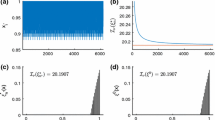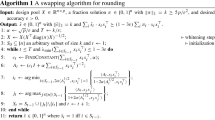Abstract
The ε-suboptimal set \(\mathcal{X}_{\epsilon}\) for an optimization problem is the set of feasible points with objective value within ε of optimal. In this paper we describe some basic techniques for quantitatively characterizing \(\mathcal{X}_{\epsilon}\) , for a given value of ε, when the original problem is convex, by solving a modest number of related convex optimization problems. We give methods for computing the bounding box of \(\mathcal{X}_{\epsilon}\) , estimating its diameter, and forming ellipsoidal approximations.
Quantitative knowledge of \(\mathcal{X}_{\epsilon}\) can be very useful in applications. In a design problem, where the objective function is some cost, large \(\mathcal{X}_{\epsilon}\) is good: It means that there are many designs with nearly minimum cost, and we can use this design freedom to improve a secondary objective. In an estimation problem, where the objective function is some measure of plausibility, large \(\mathcal{X}_{\epsilon}\) is bad: It means that quite different parameter values are almost as plausible as the most plausible parameter value.
Similar content being viewed by others
References
Ben-Tal A, Nemirovski A (2001) Lectures on modern convex optimization: Analysis, algorithms, and engineering applications. MPS-SIAM Series on Optimization
Bertsekas D, Nedić A, Ozdaglar A (2003) Convex analysis and optimization. Athena Scientific, Belmont
Bonnans J, Shapiro A (2000) Perturbation analysis of optimization problems. Springer, Berlin
Borwein J, Lewis A (2000) Convex analysis and nonlinear optimization: theory and examples. Springer, Berlin
Boyd S, El Ghaoui L, Feron E, Balakrishnan V (1994) Linear matrix inequalities in systems and control theory. SIAM, Philadelphia
Boyd S, Vandenberghe L (2004) Convex optimization. Cambridge University Press, Cambridge
Eldar Y, Beck A, Teboulle M (2007) A minimax Chebyshev estimator for bounded error estimation. CCIT Report, 617, EE Department, Technion
Fisher N, Hall P, Turlach B, Watson G (1997) On the estimation of a convex set from noisy data on its support function. Am Stat Assoc 92:84–91
Grötschel M, Lovasz L, Schrijver A (1988) Geometric algorithms and combinatorial optimization. Springer, Berlin
Lucchetti R (2006) Convexity and well-posed problems. Springer, Berlin
Markovitz H (1952) Portfolio selection. J Finance 7(1):77–91
Nesterov Y (2003) Introductory lectures on convex optimization: a basic course. Springer, Berlin
Polyak B (1987) Introduction to optimization. Optimization Software, New York
Prince J, Willsky A (1990) Reconstructing convex sets from support line measurements. IEEE Trans Pattern Anal Mach Intell 12(4):377–389
Rockafellar R (1970) Convex analysis. Princeton University Press, Princeton
Silverman BW, Titterington DM (1980) Minimum covering ellipses. SIAM J Sci Stat Comput 1(4):401–409
Skiena S (1991) Probing convex polygons with half-planes. J Algorithms 12(3):359–374
Sun P, Freund R (2004) Computation of minimum-volume covering ellipsoids. Oper Res 52(5):690–706
Wright S (1997) Primal-dual interior-point methods. SIAM, Philadelphia
Yildirim E, Wright S (2002) Warm-start strategies in interior-point methods for linear programming. SIAM J Optim 12(3):782–810
Author information
Authors and Affiliations
Corresponding author
Additional information
This material is based upon work supported by the Focus Center Research Program Center for Circuit & System Solutions award #2003-CT-888, by JPL award #I291856, by Army award #W911NF-07-1-0029, by NSF award #ECS-0423905, by NSF award #0529426, by DARPA award #N66001-06-C-2021, by NASA award #NNX07AEIIA, by AFOSR award #FA9550-06-1-0514, and by AFOSR award #FA9550-06-1-0312.
Rights and permissions
About this article
Cite this article
Skaf, J., Boyd, S. Techniques for exploring the suboptimal set. Optim Eng 11, 319–337 (2010). https://doi.org/10.1007/s11081-009-9101-7
Received:
Accepted:
Published:
Issue Date:
DOI: https://doi.org/10.1007/s11081-009-9101-7




